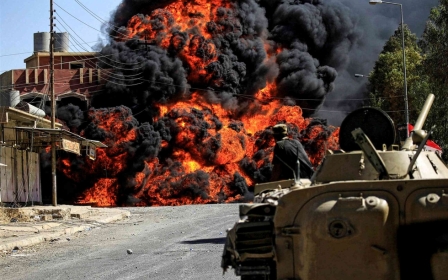Sunni vs Shia: The New Statesman's latest cover draws ire

The New Statesman, a British weekly political magazine, has been accused of “fanning the flames of sectarianism” in the Middle East after its most recent cover, illustrated by a cartoon of two armed Muslim men confronting each other, carried the headline “Sunni vs Shia” for the fourth time since 2014.
Frederic Wehrey, senior fellow in the Middle East Programme at the Carnegie Endowment for International Peace, called it a “lazy shorthand way of reducing the region's complexity”.
Wehrey added that the portrayal of the region and of divisions within Islam “has an audience… the sectarian narrative is out there.”
Fanar Haddad, senior research fellow at the Middle East Institute, told MEE: “One of the problems with the word ‘sectarianism’ is that it implies a relation to religion.
“People assume that it refers to some form of conflict between two religious groups and that therefore religion, and by extension doctrinal difference, are what is at stake,” Haddad said, adding that “this flawed assumption forms the basis for notions of an intractable ‘1.400 year old conflict’.”
Social media users were quick to notice the repetition, as the cover sparked criticism for what some considered the ‘flattening’ geo-political complexities in the region.
This is not the first time Western commentary on the so-called Sunni-Shia divide in the Middle East has sparked outrage.
In 2013, US President Barack Obama’s claim in his State of the Union address that unrest in the Middle East was “rooted in conflicts that date back millennia” drew a barrage of corrections on social media.
PhD candidates Benjamin Denison and Jasmin Mujanovic wrote in the Washington Post that writing of conflicts in this way “makes it easy for international actors to excuse their lack of coherent policy.”
Speaking to MEE and referring to the New Statesman cover, Wehrey said that scholars had “rejected these notions of ancient hatreds, of centuries old conflict within Islam,” because these depictions bear little resemblance to reality.
Saudi Arabia vs Iran is always a “front and centre” theme when sectarianism in the region is discussed, according to Wehrey.
Haddad said: “As for Saudi-Iranian rivalry, it is again not a struggle over religious truths,” adding that “Sunni-Shia competition is not irrational, pre-modern… The mystification of sectarian identities and sectarian competition is unwarranted.
“Sectarian identities can be politicised and inflamed just as they can be subsumed into irrelevance.”
Journalist and author Mehdi Hasan has argued that regional conflicts are about “power” not “piety,” attributing the Sunni-Shia conflict’s beginnings to the rise of “petro-power Saudi Arabia on the Sunni side and revolutionary power Iran on the Shia side”.
The piece accompanying the image, "How Iran’s rise is remaking the Middle East", was written by Michael Axworthy, the same person who wrote the previous piece, "Sunni vs Shia: the roots of Islam’s civil war", accompanying one of the remaining three covers of the magazine with the same headline.
Axworthy wrote: "Most Islamic terrorism in the last 20 years, overwhelmingly, has been carried out by Sunni extremists, not Shias or Iranians."
Perhaps Hasan, a New Statesman contributing writer and the magazine's former political editor, should have a quiet word with his colleagues.
Stay informed with MEE's newsletters
Sign up to get the latest alerts, insights and analysis, starting with Turkey Unpacked
Middle East Eye delivers independent and unrivalled coverage and analysis of the Middle East, North Africa and beyond. To learn more about republishing this content and the associated fees, please fill out this form. More about MEE can be found here.




